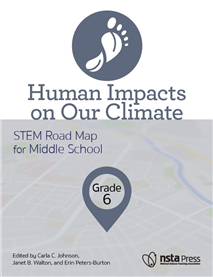All Instructional Materials resources
NSTA Press Book
The NSTA Atlas of the Three Dimensions
Download and read a sample chapter from this book to learn more.A key aspect of learning in K–12 education is the idea that what students know and are able to do grows and evolves over time. Simple ideas learned in the early elementary grades gain...
By Ted Willard
NSTA Press Book
STEM, Standards, and Strategies for High-Quality Units
New in 2020!Download and read a sample chapter from this book to learn more.Do you, your school, or your school district want to align your science curriculum with state standards while meeting the growing demand for STEM instruction? If so, this is ...
By Rodger Bybee
NSTA Press Book
The Changing Earth, Grade 8: STEM Road Map for Middle School
New in 2020! Download and read a sample chapter from this book to learn more.What if you could challenge your eighth graders to help people recognize the inherent risks of living in a region that’s prone to flooding, earthquakes, and volcanoes? Wit...
Journal Article
Distributing Expertise to Integrate Computational Thinking Practices
By MICHAEL CASSIDY, ELI TUCKER-RAYMOND, AND GILLIAN PUTTICK
Journal Article
In this secondary-level lesson, students will generate and prioritize questions about the novel coronavirus and evaluate scientific and/or technical information from multiple authoritative sources, assessing the evidence and usefulness of each source...
By William Reed
NSTA Press Book
Uncovering Student Ideas About Engineering and Technology: 32 New Formative Assessment Probes
New in 2020! Download and read a sample chapter from this book to learn more.Have you been wondering how well your students understand engineering and technology concepts? Have you been wishing for formative assessment tools in both English and Spani...
By Page Keeley, Cary Sneider, Mihir Ravel
Journal Article
Spicing Up Your Classroom With Games
When was the last time you sat in a classroom as a student instead of as the teacher? Did you notice what types of activities you enjoyed and which frustrated or bored you? I have found profound professional development as a student—and the subject...
By Melanie Pearlman
Book Chapter
Human Impacts on Our Climate, Grade 6: STEM Road Map for Middle School (Book Sample)
What if you could challenge your sixth graders to come up with a way to help tackle climate change in their own community? With this volume in the STEM Road Map Curriculum Series, you can! Human Impacts on Our Climate outlines a journey that will ...
Blog Post
How PLCs Helped Move Us Toward Equitable High School Assessment Practices
My colleagues and I began using units intentionally designed for the NGSS for biology in early 2017. We started with a high-quality unit evaluated by my colleagues on the Science Peer Review Panel, and eventually used a full program from the unit’s...
By Holly Hereau
Blog Post
PLNs + High-Quality Units = NGSS Success
In June 2013, Kentucky’s Board of Education officially adopted the Next Generation Science Standards (NGSS), which not only set a new course for science education in Kentucky, but also started me on a new professional journey. As the newly-minted s...
By David Grossman
NSTA Press Book
Creating Engineering Design Challenges: Success Stories From Teachers
If you’ve ever wished for advice you can trust on how to make science and math more relevant to your middle or high school students, Creating Engineering Design Challenges is the book for you. At its core are 13 units grounded in challenge-based le...





